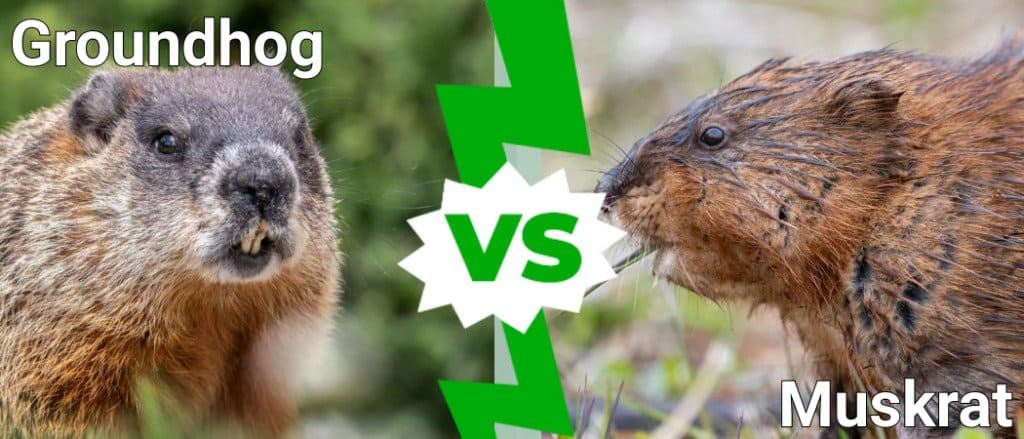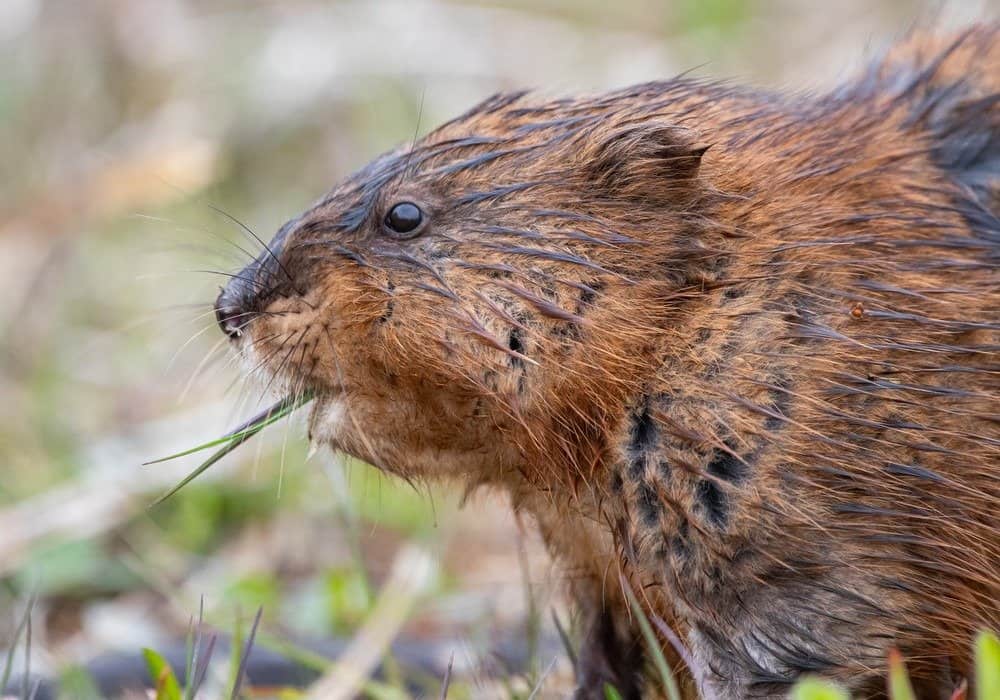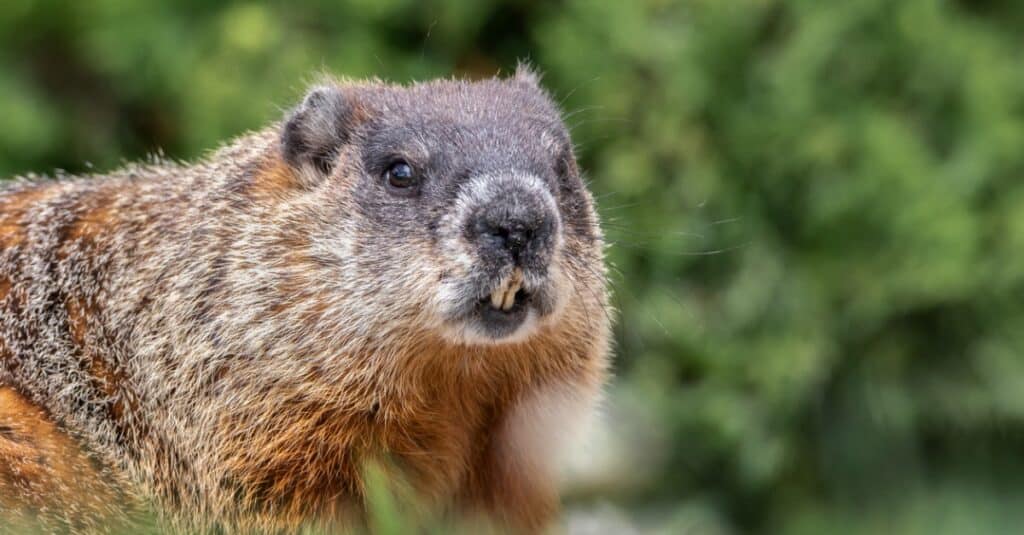Groundhogs and muskrats are animals that go by, quite literally, dozens of names each. With all those names, as well as their physical similarities, it’s easy to confuse them with one another. Today, we are going to be taking a deep dive into the differences between a groundhog and a muskrat so we can better understand what makes them unique. Soon, you’ll be able to identify and understand their differences like a pro! Let’s get started.
Comparing a groundhog and a muskrat

| Groundhog | Muskrat | |
| Size | Weight: 10-13 lbs Height: 1-2 feet standing up Length: 2 feet | Weight: 1-4 lbs Height: 5 inches Length: 16-15 inches |
| Range and habitat | Most of the United States east of the Mississippi, almost all of Canada. Prefers lowland fields and meadows near a treeline. | Most of North America, Mexico, and Eurasia. Semi-aquatic animal that prefers lakes, ponds, and wetlands. |
| Diet | Grasses, flowers, shrubs, roots, agricultural crops | Technically omnivorous, prefers aquatic vegetation like cattails, water lilies, watercress |
| Most active when | Diurnal, forages and digs during the day, retreats to den at night | Nocturnal, retreats to den during the day |
The greatest differences between a groundhog and a muskrat are their size, habitat, and hours active. When it comes to size, groundhogs are significantly larger than muskrats. Where groundhogs are larger than your average house cat, muskrats look like a beaver that happens to be the size of a large rat.
The habitat that the two live in is quite different as well. Groundhogs are terrestrial animals that live and burrow in the earth. They prefer lowland fields and meadows, usually near a forested tree line. Muskrats, on the other hand, are semi-aquatic animals adapted for life in the water. They can be found near swamps, ponds, streams, or any other wetland habitat.
Additionally, the hours that these two animals are active are opposite (an important note if trying to identify them). Groundhogs are diurnal, meaning they are active during the day and sleep at night. Muskrats are nocturnal, coming out at dusk and sleeping during the day.
While there are other differences between these two animals, these three are the most notable. Still, there is so much that makes each animal unique and adapted to its ecological niche. Let’s take a deep dive into these primary reasons, as well as a few extras, below.
Groundhog Vs Muskrat: Size

Groundhogs are 3-4 times bigger than muskrats, who are mostly aquatic.
©Scott Canning/Shutterstock.com
Size is one of the easiest notes of difference between the two when trying to identify them. Groundhogs generally weigh between 10-13 lbs, making them the second-largest member of the marmots, only behind the hoary marmot. Although both animals are rodents (part of the Order Rodentia), groundhogs are 2-4 times larger than their muskrat cousins.
Muskrats, as their name implies, are rodents, although they are closer related to lemmings and voles than to groundhogs. They can weigh between 1-4 lbs, making them significantly smaller than groundhogs. Their size and number lend them to be one of the foundational prey sources for many larger animals. Birds of prey, coyotes, mink, wildcats, and a great many other predators rely on these small animals as an important source of food.
Groundhog Vs Muskrat: Range and habitat

Groundhogs live exclusively on land, while muskrats live much of their lives in the water.
©iStock.com/Jean Landry
While both groundhogs and muskrats share a similar range, the habitat that they inhabit within that range couldn’t be further apart. Groundhogs live across the United States, almost everywhere east of the Mississippi. Additionally, they can be found in almost all of Canada, east to west, and everywhere in between. Groundhogs are 1 of 15 species of marmot, many of which are found in the United States. Wherever you can’t find groundhogs, it’s likely that one of their cousins has occupied that niche (for example, the prairie dog and the yellow-bellied marmot in the western US). When it comes to habitat, groundhogs prefer fields, meadows, and open regions where the soil is well-drained. They will generally pick a location near a tree line but can be found anywhere there is space for them.
Muskrats also have an extremely large range. Native to North America, they range from the east coast to the west coast, all the way north through Canada and into Alaska. The only places in the US that they don’t inhabit are locations in the south where waterways that they depend on don’t exist. Muskrats also live in Europe and Asia, although this was the result of human introduction as a potential fur source. When it comes to habitat, muskrat need wetlands as they are semi-aquatic animals that spend most of their lives in or near the water. They can be found near rivers, streams, ponds, lakes, swamps, and even canals.
Groundhog Vs Muskrat: Diet

Both
groundhogs and muskrats eat vegetation, but groundhogs eat mostly grass
while muskrats eat aquatic vegetation.
©Sergey Uryadnikov/Shutterstock.com
Groundhogs are technically omnivores, although they mostly eat plant material. Their diet includes grasses, plants, flowers, tree bark, and human crops (they can be pests). Occasionally, they have been known to eat grubs, snails, and other small insects, but plant material is their main food source.
Muskrats are also technically omnivores but, like the groundhog, eat a primarily vegetarian diet. They play an important role in keeping aquatic vegetation in check, especially when it comes to certain species of invasive cattails. Additionally, they are known to eat water lilies, watercress, and other vegetation. When they do dip into carnivorous diets, it is primarily made up of frogs, crayfish, mussels, and small fish.
Groundhog Vs Muskrat: Most active at what times
Groundhogs are diurnal, meaning they are active during the day and sleep at night (just like humans). At night, they head into their ground dens and sleep. When they are awake, they forage, expand their burrows, and maintain their habitat. Groundhogs play an important role as environmental engineers through their burrowing and activity, similar to how a beaver creates ecosystems through its dams.
Muskrats are the opposite of groundhogs, meaning they are nocturnal. During the day, muskrats will hide away (especially with how many predators they have) and wait to come out at dusk. When night falls, muskrats are active, eating vegetation and expanding their dens.
The photo featured at the top of this post is © iStock.com/BrianEKushner
Thank you for reading! Have some feedback for us? Contact the AZ Animals editorial team.






